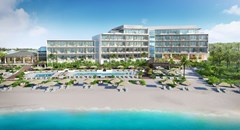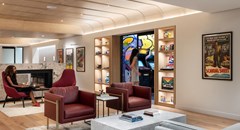By David W. Dunlap | The New York Times
Something remarkable is happening where Greenwich Street used to run through the World Trade Center site.
It is becoming Greenwich Street again. For the first time since reconstruction of the trade center began, a New York City streetscape is taking form. There are sidewalks and curbs, oak trees and honey locusts, street lamps and pigeons. And, as on any street near high-risk targets, there are also ranks of heavily reinforced posts, or bollards.
But even with the bollards, the scene is appealingly open. Only security guards prevent visitors to the National September 11 Memorial from simply walking across Greenwich Street and up to the lobby of 4 World Trade Center, now under construction.
The intersection offers palpable evidence that the monolithic 16-acre superblock that existed before Sept. 11, 2001, has truly been pared down. Amanda M. Burden, the director of the City Planning Department, said the agency had pushed to re-establish Greenwich and Fulton Streets running through the trade center site as a way of integrating the complex with Lower Manhattan.
"The use of sidewalk materials and their layout complement the memorial in a sophisticated and subtle manner," she wrote in an e-mail on Tuesday. "There were countless mock-ups and sample reviews to make sure that we got the selection of granite, finishes, proportions and layout just right, including full-scale mock-ups. "We were also intensively engaged in the bollard design, helping to facilitate an elliptical and tapered form that is effective from a security standpoint but not intrusive in size," Ms. Burden added. The portion of Greenwich Street between Vesey and Liberty Streets has existed in recent years, but only as a construction haul road. Seeing the partly finished landscaping brings home the fact that one day it will be restored to traffic, though on a highly restricted basis.
The Port Authority of New York and New Jersey is constructing the new section of Greenwich Street, which it expects to complete by the end of 2014. Some time around then, or early in 2015, the authority will move its headquarters into 4 World Trade Center. Four World Trade Center is a deliberately understated building that cuts the lowest profile of any in the complex (if a 977-foot tower can be said to cut a low profile). As designed by Fumihiko Maki, 84, of Maki and Associates in Tokyo, it also contributes a great deal to the streetscape.
Unlike the rest of the tower, which is skinned in reflective glass, the building's 47-foot-high lobby is clad in clear glass. It almost seems to embrace the street, a gesture made even stronger by an 80-foot-wide space between columns.
The closeness of the lobby to the memorial imposed a special obligation on Mr. Maki and his client, Silverstein Properties, to create a space that was respectful without being sepulchral.
Last week, their intentions for the lobby became clear with the installation of "Sky Memory," a delicate, 98-foot-diameter titanium arc by the sculptor Kozo Nishino, of Kyoto, Japan. This is his first commission in the United States. Mr. Nishino has collaborated with Mr. Maki before. But his trade center commission owes itself to a visit by the developer, Larry A. Silverstein, and his wife, Klara, to the ArtCourt Gallery booth at a 2007 art fair in New York City. The gallery represents Mr. Nishino and was showing a model of his work.
"I had no idea about Larry," recalled Mitsue Yagi, the gallery director. "I said, ‘This artist makes huge-scale artwork.' Larry said, ‘I'm making a very big building.'"
Despite its great size, the "Sky Memory" sculpture weighs only 474 pounds. It is composed of seven sections of welded, exposed trusswork that are cantilevered and balanced 22 feet above the lobby floor, as if they were floating. The metal shifts in color from deep sapphire blue to pale jade green.
Reflected in the polished black granite wall from which it springs, the arc looks like a circle. Or a zero. Could that be an intentional reference to "ground zero" by an artist whose works are found in the two Japanese cities on which the United States dropped atomic bombs during World War II?
"It's less about capturing a moment of time in the past," Mr. Nishino answered during a conversation at the site. "It's more about looking into the future."
A few days later, he wrote in an e-mail that he had begun thinking about the meaning of ground zero in New York, Hiroshima and Nagasaki.
If the setting of 4 World Trade Center turns out to be thought-provoking as well as attractive, Greenwich Street, north of Liberty, will be a very good streetscape indeed.


